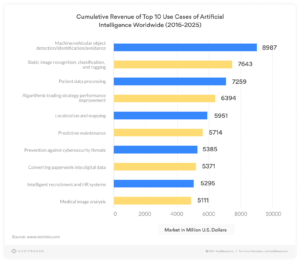While working in the tech industry and living in such a fast-paced world, we are often forced to reflect on the impact of all the developments we are currently experiencing. Fifty years ago, people would never have dreamed that they would have a cell phone that could call their friends, take pictures, send messages, and work, not to mention smart technology that could eliminate human labor in many ways.
At first glance, this seems unthinkable, but recent advances and news have shown us that the future is now. How could anyone have imagined 10 years ago that a machine could create realistic images and artwork from a description in natural language? It would have sounded surrealistic, to say the least. Today, this is no longer a surprise.
How can a machine do that? Well, a complete answer to that is extremely complex and we could hardly explain it to you in detail in a single blog article. Simply put, Artificial Intelligence (AI) enables machines to learn from various experiences and perform human-like actions/tasks in a wide variety of contexts. You may have heard of chess-playing computers, of Alexa and Siri, and of self-driving cars as very well-known AI examples. They all rely heavily on Deep Learning, which allows computers to be trained to perform specific tasks, by processing large amounts of data and detecting patterns in that data.
In this article, we will not go into detail about what AI is, as you can already find a lot of good material on the Internet (and we have already spoken a bit about it as well). Rather, we would like to discuss the benefits and risks of Artificial Intelligence that exceeds human imagination and what this could mean for all of humanity.
As per usual, let’s begin with the positive first.
The Power
1 – Manual tasks can be automated so that AI can perform frequent, large-scale tasks in a computerized manner. In this way, a lot of time is saved, which increases the quality of the final product.
2 – AI gives intelligence to the product. Most products you know today can be improved by AI capabilities. Most likely Siri, which you have been using for years, has been significantly improved over from 3, 5, or 7 years ago. Its automation and conversation features have become much more accurate. This is also true for many other products/areas such as smart cameras, security intelligence, investment analytics, and many others. Deloitte’s Global Artificial Intelligence Industry whitepaper predicts that the world will experience $15.7 trillion in AI-driven GDP growth by 2030. The paper primarily outlines the application of AI technology in major cities around the world and the profound changes it will bring to various industries such as finance, education, digital government, healthcare, autonomous driving, retail, manufacturing, and smart cities once it reaches the commercialization stage. AI applications are continuing to develop across organizations and industries, as shown by the figure below.

(source: https://www.auditboard.com/blog/what-are-risks-artificial-intelligence/ )
3 – AI has the potential to adapt through progressive learning algorithms. Its algorithms acquire capabilities through certain structures and regularities in the massive data to which they have access. An algorithm can teach itself to play different games, recommend products to you online based on your tastes, or instantly recognize a threat at home (security) or on the road (autonomous vehicles). It can do all this thanks to the huge amounts of data it consumes, and its improvement comes from the fact that more and more data is being collected each day that passes.
4 – Artificial Intelligence analyzes data much deeper and penetrates hidden layers. This is very useful when it comes to detecting fraud, which seemed impossible years ago. Detecting fraud in a dynamic global environment with an overwhelming amount of data and traffic to monitor can be extremely difficult. Using AI to detect fraud has enabled organizations to improve internal security, as it has become possible to effectively prevent financial crime. Now, large volumes of transactions can be analyzed to uncover fraud trends, which can lead to real-time fraud detection. If fraud is suspected, AI models can reject transactions altogether or flag them for further investigation.
5 – The accuracy AI provides using deep neural networks is incredible. Take your interactions with Alexa and Google. Did you know that they are all based on Deep Learning? You have noticed that the more you use them, the more accurate they become. When medicine started incorporating AI into its work, it could not have imagined (perhaps only hoped) that it would now be able to detect cancer in medical images.
6 – The accuracy that AI provides using deep neural networks is incredible. For example, when medicine began incorporating AI into its work, it could not have imagined (perhaps only hoped) that it would now be able to detect cancer in medical images. AI in medicine uses machine learning models to search for accurate medical data and provide insights that make doctors’ jobs easier. Thanks to current advances, AI has quickly entered the healthcare field and has become a fundamental tool for medical professionals when it comes to making decisions about treatments, medications, and other patient needs.
7 – Data alone means nothing, although it is a great asset when algorithms are self-learning. Experts in the field will tell you that you have all the answers you need on the data that is available to you. All you need to do is apply AI to find them. As many have now realized, data is of tremendous importance as it is a major competitive advantage for businesses today. In a competitive industry, data wins when you have the best and most of it.
8 – Using AI and machine learning in your business means reducing the workload of your employees and eliminating unnecessary processes that would have slowed down your growth. In this way, companies are able to respond to demands on a larger scale with greater efficiency. An example of this is the Illinois Department of Innovation and Technology, which implemented AI into its processes during the Covid era. It had a chatbot that had over 20 million conversations with virtual agents, with a success rate of over 90%. Ultimately, this meant that employees were unburdened during such a critical time as the Covid pandemic, when companies were faced with a completely new reality, allowing them to use their human resources more effectively.
It is important to say that as the benefits of AI increase, so do the risks. Let’s explore that.
The Risks
1 – Developing a machine that simulates and sometimes surpasses human intelligence comes at a high cost. Ensuring you have the best AI requires a lot of time and resources.
2 – Unfortunately, much of the data currently available tends to be biased toward men, heterosexuals, and white people due to the injustices in our history. It is important that we balance data in a fair way so that our AI is not fixed on one gender, sexual orientation, ethnicity, etc. Since AI systems will make their decisions based on the data they were trained with, and if that data is biased towards, say, a particular gender, that could mean that a person of the opposite gender will most likely get an unfair outcome. In a fair world, we need to train AI to fight discrimination against people, not further it.
3 – Some people argue that AI and machine learning lack creativity. It can learn an unimaginable amount of processes and information, but so far it has not been able to think outside the box. The approach it takes lacks a human touch because it relies only on previously fed data. However, one could argue why a machine should be more creative than a human, but that is a topic for another discussion.
4 – One of the biggest concerns discussed by the vast majority of people regarding AI is that it is slowly replacing a number of repetitive tasks with bots. This automatically means that in the next few years the need for human intervention will greatly diminish, leading to the elimination of many jobs. Truth be told, in every phase of industrialization, people had to learn to adapt to the new rules, and this time will be no different (we hope). What worries people is the fact that this evolution is happening very fast, so people do not have a chance to adapt to this new reality as quickly as they wished. A study by McKinsey predicts that AI will replace at least 30 percent of human labor by 2030. We hope that new jobs will also be created by then.
5 – While job loss is one of the most pressing issues related to AI disruption, it is only one of many potential risks. In a paper titled “The Malicious Use of Artificial Intelligence: Forecasting, Prevention, and Mitigation,” 26 researchers from 14 different institutions came up with a list of other threats that could cause serious harm – or at least a little chaos – in less than five years.
“Malicious use of AI could threaten digital security (e.g. through criminals training machines to hack or socially engineer victims at human or superhuman levels of performance), physical security (e.g., non-state actors weaponizing consumer drones), and political security (e.g. through privacy-eliminating surveillance, profiling, and repression, or through automated and targeted disinformation campaigns).” In terms of surveillance, there is no better example than China’s “Orwellian” use of facial recognition technology in offices, schools, and other public places.
We can only guess whether AI will one day appear to be a fair trade-off for greater security, even if it is nefariously exploited by malicious actors.
The same is true for the so-called audio and video forgeries (deepfakes) that result from the manipulation of voices and likenesses. By using AI, an audio clip of any politician could be manipulated to make it look like that person made racist or sexist remarks, when in fact they said nothing of the sort. If the quality of the clip is high enough to deceive the public and not be detected, it could completely destroy a person, or a political campaign and end up jeopardizing global security.
And all it takes is one success. After that, no one knows what is real and what is not. That leads to not being able to trust your own eyes and ears, and not being able to rely on what we thought was the best possible evidence in the past. And that can be a big problem.
6 – As AI automates tedious and repetitive tasks, one would say that it has the power to make people even lazier than they’d otherwise be. Since everything is automated, we no longer have to solve puzzles or memorize information, which means our brains are used less and less. This ease can have great negative effects on future generations. On the other hand, this could be a hidden advantage, because by eliminating repetitive tasks, people can finally have the time and opportunity to devote themselves to more creative tasks, which is precisely what we are good at!
7 – The lack of transparency & black box algorithms can be problematic. The main purpose of AI systems is to make predictions, and as such, algorithms can be so immensely complex that even those who developed the algorithm cannot explain exactly how the variables combine to produce the resulting prediction. This lack of transparency is why some algorithms are referred to as “black boxes” and why lawmakers are now beginning to explore what checks and balances need to be put in place. For example, if a bank customer is rejected based on an AI prediction of their creditworthiness, companies run the risk of not being able to explain why.
8 – And now, we’ve arrived t the unclear legal responsibility issue. Given the potential risks of AI discussed so far, these concerns lead to the question of legal responsibility. If an AI system is designed with fuzzy algorithms and machine learning refines the decision-making itself, who is legally responsible for the outcome? Is it the company, the development team, or the system? This risk is not theoretical – in 2018, a self-driving car hit and killed a pedestrian. In that case, the car’s human passenger was inattentive and was held responsible for the AI system’s failure. This also leads us to the topic of ethics.
9 – Every time a discussion about Artificial Intelligence comes up, someone raises the issue of ethics and morality. These are indeed very important human characteristics that are very difficult to incorporate into AI. As AI grows and evolves, it may evolve in a direction that is unpredictable to us (as previously mentioned), as we lose control of it and eventually erase human notions. When the late physicist, Stephen Hawking, visited Portugal, he also mentioned that AI’s impact could be cataclysmic unless its rapid development is strictly and ethically controlled.
“Unless we learn how to prepare for, and avoid, the potential risks,” he explained, “AI could be the worst event in the history of our civilization.”
Overall
The risks of Artificial Intelligence are significant, but the use of these technologies and their growth are also inevitable. (Some) of the benefits, we have mentioned in this article go beyond simple efficiencies to include a fairer decision-making scenario when algorithms are trained to avoid bias. It is clear the massive potential it has in creating a fairer, better, and simpler world to live in.
As we learn more about Artificial Intelligence, we should pay attention to the key features of AI systems:
– AI systems should include clear design documentation.
– Machine learning should include testing and refinement.
– AI control and governance should take precedence over algorithms and efficiency.
We all, without exception, have a responsibility to learn more about the risks of AI to make sure it doesn’t get out of hand. The issues and the problems around Artificial Intelligence will not go away, and the risks will continue to grow and change as the technology becomes more advanced and ubiquitous. Companies that embrace the three points above will be better able to manage the risks of AI systems that could otherwise have devastating legal and reputational consequences.
That is why having a specialized team help you take the first steps in implementing AI systems in your organization is critical. Contact us for more information. We will be happy to help you.
Note: a warm thank you to my colleague, Pedro Oliveira, for giving me valuable insights on this topic.















